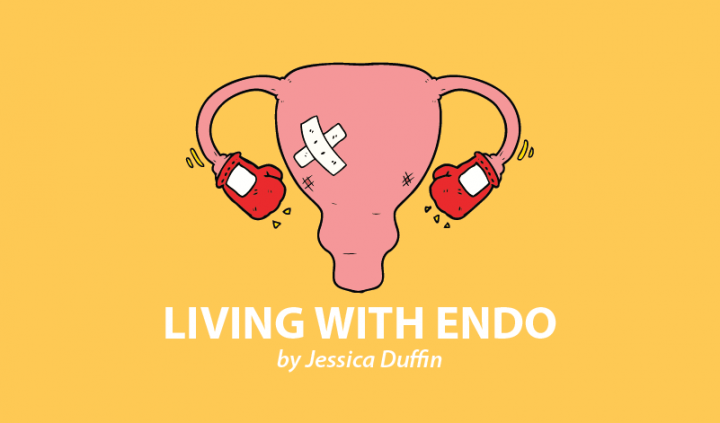Did you know this month is Plastic Free July?
Plastic Free July is a global challenge that encourages people to minimize or go plastic-free in the month of July. I’ve been doing some work on the movement for a project, and it’s inspired me to think about endometriosis and our environment.
Pads are 90 percent plastic, and unless you’re specifically buying an eco-friendly brand, all pads, tampons, and panty liners have some kind of plastic in them. Plastic doesn’t break down for years, decades, or even centuries. Period products are estimated to take 250 to 500 years to biodegrade, which explains why a beach cleanup here in the U.K. found roughly 23 sanitary pads and nine tampon applicators per kilometer.
Many of us are becoming more aware of the impact our lives have on the environment and are trying to do our best to make positive changes. In the U.S., it’s estimated that 7 million tampons and 12 billion pads will end up in landfills. And that’s not accounting for the numbers that end up flushed down toilets and are found in rivers, seas, and oceans. But as many of us with endometriosis experience long and heavy periods, the use of pads are a necessity — and not something that should cause us to feel shame or blame.
Thankfully, every year there seem to be more sustainable solutions. Today, I want to share a few in case you are inspired to make the switch.
Period panties
I had wanted to invest in a pair of period underwear for a few years, but they were out of my price range. I recently invested in a pair, and now I hope to one day buy enough for five to seven days. Most of the ones I’ve seen on the market are around $40 to $50 per pair, but it’s one of those purchases where you have to consider what it’ll be saving you in the long run.
The purpose of period underwear is that they’re reusable and can also replace disposable pads and tampons (hence having to buy less). This is obviously dependent on your flow, but I find that I prefer to wear them with a pad on Day 1 and Day 2 and can happily wear them without by Day 3.
I’ve found period panties to be really comfortable, reassuring (no leaks), and dare I say it — even glamorous and a tiny bit sexy? It’s also a huge bonus to know I’m not throwing away large amounts of plastic wrapping and sanitary products every month.
However, it’s also important to note that they won’t last forever. Period panties are for sure a more sustainable option, but most brands mention somewhere on their website or packaging that they’ll have to be replaced after a certain period of time.
Biodegradable period products
I’m a huge fan of biodegradable period brands, such as TOTM. Whereas most pads and tampons won’t biodegrade, there are now brands working hard to ensure that their products and even their packaging are biodegradable — meaning they will break down in landfills. These companies also minimize or eliminate the use of harmful chemicals, too, ensuring that the cotton used in tampons is organic, for example.
It’s worth noting that some don’t state that their products are biodegradable, but that they do use organic materials and sustainable processes. If you can’t get your hands on a biodegradable brand, then these are great alternatives, too.
Menstrual cups
Arguably, menstrual cups are one of the most eco-friendly options for periods. Most are made from natural materials, such as silicone, and are by design reusable, long-lasting, and sustainable.
Menstrual cups fold up for insertion and then open inside the vaginal canal and collect blood before being emptied. Most users I’ve met rave about them, and find that after one or two tries they’ve mastered the art and would never go back.
However, I’m not 100 percent sure the same can be said for those of us with endometriosis. The one and only time I tried a menstrual cup it was really pretty painful.
But don’t dismiss them, as I know people with endo who do use them. I just found they weren’t for me.
Reusable pads
Similar to period panties, reusable pads are exactly as they sound: sanitary pads that can be washed and worn again. They’re made out of cotton or some kind of cloth and have poppers underneath to secure them in place.
These are harder to come by, but there are quite a few brands online and even a few on Etsy, so shop around to see if you can find any that work for you.
Plenty of sustainable options exist for those of us who are inspired to make an impact on our environment. We just have to take the time to look.
***
Note: Endometriosis News is strictly a news and information website about the disease. It does not provide medical advice, diagnosis, or treatment. This content is not intended to be a substitute for professional medical advice, diagnosis, or treatment. Always seek the advice of your physician or other qualified health provider with any questions you may have regarding a medical condition. Never disregard professional medical advice or delay in seeking it because of something you have read on this website. The opinions expressed in this column are not those of Endometriosis News or its parent company, BioNews Services, and are intended to spark discussion about issues pertaining to endometriosis.

